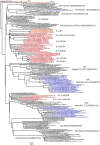Association between prognostic factors and the outcomes of patients infected with SARS-CoV-2 harboring multiple spike protein mutations
- PMID: 34725366
- PMCID: PMC8560824
- DOI: 10.1038/s41598-021-00459-4
Association between prognostic factors and the outcomes of patients infected with SARS-CoV-2 harboring multiple spike protein mutations
Abstract
The outcome of SARS-CoV-2 infection is determined by multiple factors, including the viral, host genetics, age, and comorbidities. This study investigated the association between prognostic factors and disease outcomes of patients infected by SARS-CoV-2 with multiple S protein mutations. Fifty-one COVID-19 patients were recruited in this study. Whole-genome sequencing of 170 full-genomes of SARS-CoV-2 was conducted with the Illumina MiSeq sequencer. Most patients (47%) had mild symptoms of COVID-19 followed by moderate (19.6%), no symptoms (13.7%), severe (4%), and critical (2%). Mortality was found in 13.7% of the COVID-19 patients. There was a significant difference between the age of hospitalized patients (53.4 ± 18 years) and the age of non-hospitalized patients (34.6 ± 19) (p = 0.001). The patients' hospitalization was strongly associated with hypertension, diabetes, and anticoagulant and were strongly significant with the OR of 17 (95% CI 2-144; p = 0.001), 4.47 (95% CI 1.07-18.58; p = 0.039), and 27.97 (95% CI 1.54-507.13; p = 0.02), respectively; while the patients' mortality was significantly correlated with patients' age, anticoagulant, steroid, and diabetes, with OR of 8.44 (95% CI 1.5-47.49; p = 0.016), 46.8 (95% CI 4.63-472.77; p = 0.001), 15.75 (95% CI 2-123.86; p = 0.009), and 8.5 (95% CI 1.43-50.66; p = 0.019), respectively. This study found the clade: L (2%), GH (84.3%), GR (11.7%), and O (2%). Besides the D614G mutation, we found L5F (18.8%), V213A (18.8%), and S689R (8.3%). No significant association between multiple S protein mutations and the patients' hospitalization or mortality. Multivariate analysis revealed that hypertension and anticoagulant were the significant factors influencing the hospitalization and mortality of patients with COVID-19 with an OR of 17.06 (95% CI 2.02-144.36; p = 0.009) and 46.8 (95% CI 4.63-472.77; p = 0.001), respectively. Moreover, the multiple S protein mutations almost reached a strong association with patients' hospitalization (p = 0.07). We concluded that hypertension and anticoagulant therapy have a significant impact on COVID-19 outcomes. This study also suggests that multiple S protein mutations may impact the COVID-19 outcomes. This further emphasized the significance of monitoring SARS-CoV-2 variants through genomic surveillance, particularly those that may impact the COVID-19 outcomes.
© 2021. The Author(s).
Conflict of interest statement
The authors declare no competing interests.
Figures

Similar articles
-
Molecular epidemiology of SARS-CoV-2 isolated from COVID-19 family clusters.BMC Med Genomics. 2021 Jun 1;14(1):144. doi: 10.1186/s12920-021-00990-3. BMC Med Genomics. 2021. PMID: 34074255 Free PMC article.
-
Persistence of SARS-CoV-2 infection and viral intra- and inter-host evolution in COVID-19 hospitalized patients.J Med Virol. 2024 Jun;96(6):e29708. doi: 10.1002/jmv.29708. J Med Virol. 2024. PMID: 38804179
-
Whole-genome sequencing of SARS-CoV-2 reveals the detection of G614 variant in Pakistan.PLoS One. 2021 Mar 23;16(3):e0248371. doi: 10.1371/journal.pone.0248371. eCollection 2021. PLoS One. 2021. PMID: 33755704 Free PMC article.
-
Characterization of SARS-CoV-2 different variants and related morbidity and mortality: a systematic review.Eur J Med Res. 2021 Jun 8;26(1):51. doi: 10.1186/s40001-021-00524-8. Eur J Med Res. 2021. PMID: 34103090 Free PMC article.
-
Comorbidities in SARS-CoV-2 Patients: a Systematic Review and Meta-Analysis.mBio. 2021 Feb 9;12(1):e03647-20. doi: 10.1128/mBio.03647-20. mBio. 2021. PMID: 33563817 Free PMC article.
Cited by
-
Sequence analysis of the Spike, RNA-dependent RNA polymerase, and protease genes reveals a distinct evolutionary pattern of SARS-CoV-2 variants circulating in Yogyakarta and Central Java provinces, Indonesia.Virus Genes. 2024 Apr;60(2):105-116. doi: 10.1007/s11262-023-02048-1. Epub 2024 Jan 20. Virus Genes. 2024. PMID: 38244104
-
Tracking the molecular evolution and transmission patterns of SARS-CoV-2 lineage B.1.466.2 in Indonesia based on genomic surveillance data.Virol J. 2022 Jun 16;19(1):103. doi: 10.1186/s12985-022-01830-1. Virol J. 2022. PMID: 35710544 Free PMC article.
-
Interpretable and Predictive Deep Neural Network Modeling of the SARS-CoV-2 Spike Protein Sequence to Predict COVID-19 Disease Severity.Biology (Basel). 2022 Dec 8;11(12):1786. doi: 10.3390/biology11121786. Biology (Basel). 2022. PMID: 36552295 Free PMC article.
-
Genomic Surveillance and Molecular Characterization of SARS-CoV-2 Variants During the Peak of the Pandemic in Türkiye.Biochem Genet. 2024 Nov 8. doi: 10.1007/s10528-024-10962-8. Online ahead of print. Biochem Genet. 2024. PMID: 39516327
-
SARS-CoV-2 Variants and Clinical Outcomes: A Systematic Review.Life (Basel). 2022 Jan 25;12(2):170. doi: 10.3390/life12020170. Life (Basel). 2022. PMID: 35207458 Free PMC article. Review.
References
-
- World Health Organization. https://www.who.int/news/item/29-06-2020-covidtimeline Accessed on July 2, 2021.
-
- World Health Organization. https://covid19.who.int/table Accessed on July 7, 2021.
Publication types
MeSH terms
Substances
LinkOut - more resources
Full Text Sources
Medical
Miscellaneous

